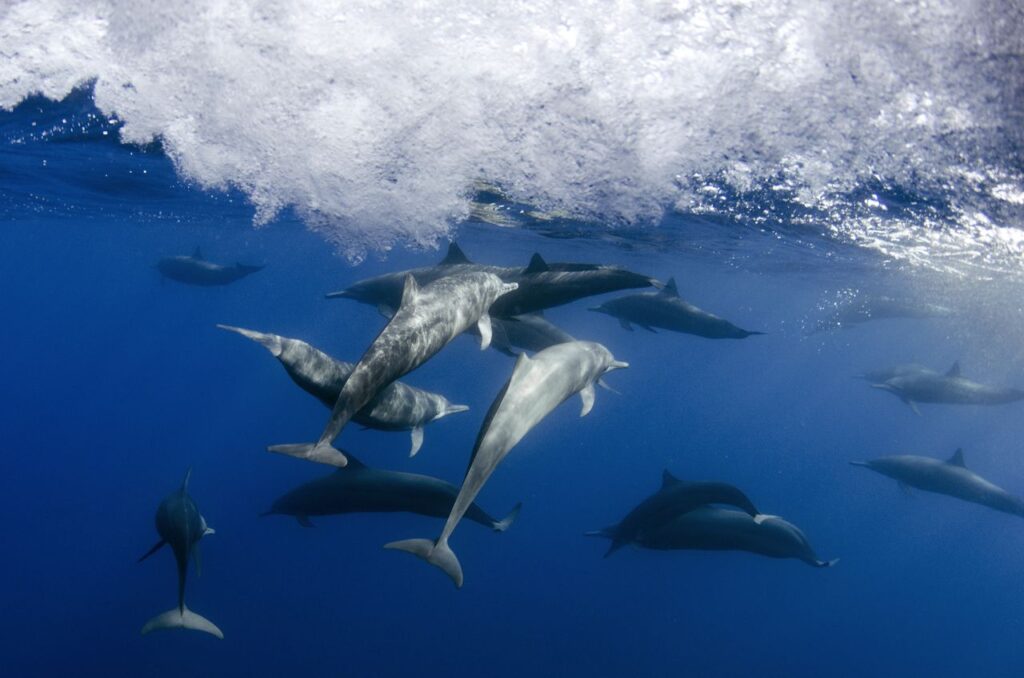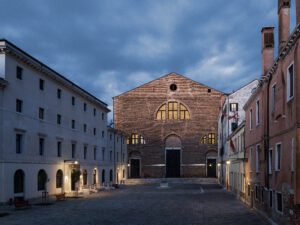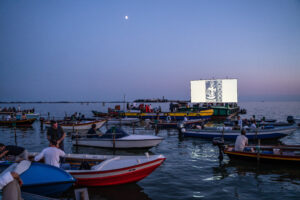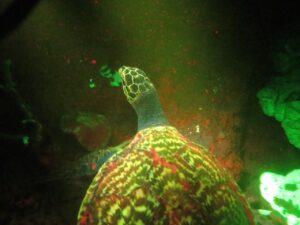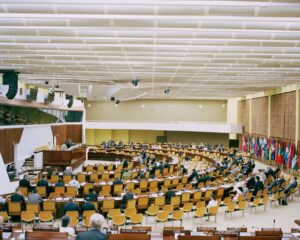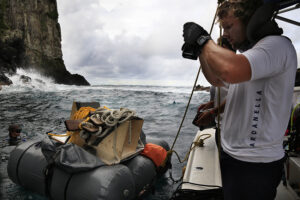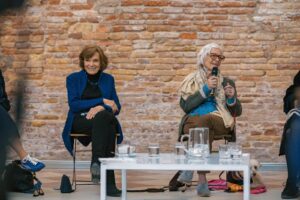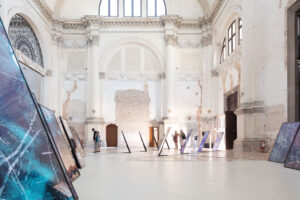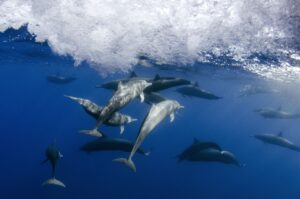Over the past decade, contemporary art organisation and cultural ecosystem TBA21—Academy has been promoting a deeper relationship to the Ocean through the prism of art and science. Covering more than 70 percent of the surface of our planet, the Ocean is at the heart of our combat against climate change and biodiversity loss.
This year is the 10th anniversary of TBA21–Academy, a contemporary art organization and cultural platform that you co-founded with Francesca Thyssen-Bornesmisza, with the express purpose of deepening our relationship to the Ocean. How and when did you think of creating this transdisciplinary space of expression and research, at the crossroad of science and art? What made you profoundly attached to the protection of the ocean?
I was formerly a competitive swimmer and have always felt at home in water. In my early summers growing up, I visited my grandmother on the west coast of Scotland, on the shores of the Firth of Clyde. It was not your typical vision of a sunny summer on white sandy beaches, but it did inspire respect and awe for the ocean’s immense power.
In 2011, I was cast by artist Walid Raad to take part in his work Scratching on Things I Could Disavow: A History of Art in the Arab World, which was the first moment of deep immersion in the art world. I had been trained as an actor, and this was my first time using my skill set offstage from major film and theatre productions. The work was commissioned by Thyssen-Bornemisza Art Contemporary and serendipitously led me to meet Francesca Thyssen-Bornemisza. Francesca also has a lifelong affinity with the ocean and had been involved in a range of philanthropic conservation efforts.
We started speaking and quickly saw an opportunity to bridge the transformative power of art to the ocean, a space that is still largely unexplored and in urgent need of advocacy and action.
So, we embarked on a journey that quickly turned into the exploratory soul of TBA21, and from there into TBA21–Academy, an autonomous center within the foundation, dedicated to art and the ocean.
TBA21–Academy has been nurturing collaborative and artistic projects that actively reshape our connection with the ocean and shed light on exceptional environmental research and discovery. What have been the most memorable adventures of the decade?
Through TBA21–Academy, I have had the privilege of working with a generous roster of inspiring artists, scientists, philosophers, musicians, writers, and academics… it really goes on. Working in contexts outside of traditional art world infrastructures and science labs has led to some memorable moments.
2014 was a major milestone for TBA21–Academy with Treasure of Lima: A Buried Exhibition (2014). It was momentous and showed the world how truly crazy we are about the ocean and the length we would go to protect it. Treasure of Lima curated by Nadim Samman was a site-specific exhibition that raised funds for the research and protection of open sea species – think sharks, dolphins, etc. – that live in the oceans surrounding the remote Isla del Coco. Artworks by major artists (including Marina Abramović, Doug Aitken, Olafur Eliasson, John Gerrard, Pierre Huyghe, Ed Ruscha, Lawrence Weiner) were buried on Isla del Coco. It is the southernmost point on the North American continent, some 500km from Costa Rica. It is a world heritage site, part of the Costa Rican national park, and home to a range of endemic animals. TBA21–Academy was particularly interested in supporting the scalloped hammerhead sharks that encircle, and some would argue, protect the island.
The Academy partnered with Phillips and commissioned an auction. The winner of the auction won a Chest & Map, designed by Aranda\Lasch and Constant Dullaart- an artwork in itself -, that provides clues on how to access this buried treasure trove. An incredible twist in the project itself is that the island is near impossible to access. The legally protected island is uninhabited apart from park rangers – tourists need permits from rangers and cannot stay overnight. There is pirate lore around it; some 300 expeditions have taken place historically in search of buried treasure (the hoard of Benito Bonito, hence Treasure of Lima). As a result, treasure hunting on the island is illegal. So should the winner of the auction plan an expedition, it would be criminal!
The funds raised by auction were dedicated to a long-term pelagic conservation project, initiated with local partners in Costa Rica, such as FAICO (La Fundación Amigos de la Isla del Coco) and Mission Tiburon. So far, 25 sharks have been tagged as a way of insight into local movements and migrations, habitat use, and behavior of pelagic species around the island.
Another adventure I hold close to my heart was the discovery of bioluminescence in Hawksbill turtles in the Solomon Islands. The marine biologist and National Geographic Explorer David Gruber and I were on a dive on a moonless night in waters filled with sharks and saltwater crocodiles exploring the local reef for its bioluminescence. Besides the corals, we had hoped to maybe catch a glimpse of an eel or ray. Never had we dreamt of stumbling onto a Hawksbill turtle and realizing their shells glow in the dark! This discovery later found its way into neuroscience and the Carl Sagan Institute in its quest for extraterrestrials.
Lastly, a huge moment that I’ll never forget was the opening of Ocean Space in Venice with a conversation between Joan Jonas and Sylvia Earle, respective pioneers and absolute trailblazers in their fields.
What started as a project about exploring humankind’s relationship to the ocean through art has now provided the organization with a seat at the table at UN-led initiatives. Can you talk about how that came about and what that has meant for TBA21–Academy and what you have been able to contribute to the conversation?
Things really changed for us in 2016, after TBA21–Academy was granted Observer Status by the International Seabed Authority – the first arts organisation to have been appointed this status! This has helped tremendously in our policy-making efforts. Our conversations with the UN began with the curiosity of Armin Linke during our first-ever Convening, staged in Kingston, Jamaica, in 2016. Having heard deep-sea mining, Armin had begun to engage with the ISA as part of his research (through Davor Vidas, who was, at the time, the chair of the International Law Association). Through this artist’s curiosity, we began to get insights into the workings of the ISA and subsequently saw the necessity – the urgency – to engage, as it was clear that deep-sea mining is an environmental disaster waiting to happen.
In 2020, TBA21–Academy successfully lobbied the European Commission to allocate 300 million euros of their climate budget proposal for the EU towards funding relevant cultural initiatives, successfully making the case that the facts are unfortunately not enough to inspire both structural and behavioral change and that culture has an important role to play in educating and motivating people, government and big business.
This achievement, getting a seat at the table, cements the role culture has in affecting change for the protection of the natural world.
The Academy attaches great importance to combining art and science in its initiatives. Why is it important to have an artistic perspective on scientific research? And, conversely, how does science contribute to artistic creation?
The work of both is incredibly important but neither exists in a silo.
By having these different ways of working, thinking and existing come together, there is greater opportunity for the unexpected cross-pollination of ideas. Science needs to question the impact of its findings. How can research heal or hurt communities and the environment?
Artists invite conversation and ways to tackle these ideas. Also, when exhibited, it invites a diverse public to engage and react in accessible ways. The data on climate change, ocean degeneration and the threat to biodiversity has existed for generations. Unfortunately, it is not enough. But it’s really much more than a combination of art and science – we bring together a wide variety of perspectives and knowledge systems, including indigenous and ancestral knowledges. One of this year’s exhibitions at Ocean Space in Venice will be Taloi Havini’s first large-scale solo exhibition in Europe. Taloi is an artist from the Autonomous Region of Bougainville in the Western Pacific. Her new work is based on the experience during the Schmidt Ocean’s Institute Artist-At-Sea program aboard their research vessel Falkor, contributing to a high-resolution mapping exercise of the Great Barrier Reef. She juxtaposes this experience with traditional forms of mapping space through storytelling. What Taloi had mentioned as interesting is that both approaches use sound to create a record. Bathymetry typically uses data collected by sonars – literally, sound bouncing off surfaces of various distances – and indigenous knowledge is often conveyed through oral histories, the act of storytelling with one’s own voice.
Ocean Space, recently opened in Venice, is the new physical and permanent location of TBA21–Academy. How much thought and attention was put into choosing the city which housed the institution? Venice is a place that is beautifully entangled with the sea, but also at the forefront of climate change. What does it mean to TBA21–Academy’s mission?
In Venice, the ocean is an ever-present reality, which is exacerbated by the ever more dramatic high-water events that are occurring in shorter and shorter intervals. Can we imagine, think and act from a city where the environmental catastrophe is tangible and the strain on the city by mass tourism and the lagoon by the cruise ship industry compounded? Beyond that, Venice has long existed as a cultural centre and meeting point, constantly allowing reflection through the arts. The Venice Biennale began in 1895, and it was founded on internationally minded principles. There is no better way to intervene with a cause that needs global collaboration and solutions than with a space that brings the international community together.
The climate crisis we face today exists beyond sovereignty and therefore needs discourse that transcends mono-cultural dialogues.
That said, we found our audience both in the local community and with the residents of the city through public programs and partner organizations such as We are Here Venice and the Venetian Institute of Marine Sciences CNR-ISMAR. At the same time, we address the global community and forge partnerships with international organizations engaging with art, research, education, and conservation. The main idea is to “stay with the trouble,” thinking and creating from a place of crisis. To think from a site of ongoing environmental disaster with a historical context of reflection through art and the practice of exchange of ideas turns out to be an incredibly productive place.
The unprecedented increase in water temperature and ocean acidification threatens the marine ecosystems and life on the planet. To what extent art, culture, and collaborative thinking can induce climate action? What are the challenges of communicating and promoting ocean stewardship?
The exhibition and programming held at Ocean Space imagines bold new ways to address rising sea-levels and challenges facing the oceans by prompting action and activism, such as completely protecting the High Seas from any extractive activities. Ocean Space hosts multidisciplinary dialogues with artists, scientists, policymakers, architects, and political advisers who can work together to address these issues. There are as many challenges as there are solutions. Global cooperation is a big driver for impactful change.
Culture is an effective form of soft power to bring oppositional agents to one table to talk through a critical lens and open new dialogues. We strive to promote and develop critical ocean literacy as a tool that provokes questions and options rather than solutions.
Even though we function as an incubator for ideas, we implement practical solutions as well, for example, in our work with the Alligator Head Foundation in Jamaica with its coral and mangrove restoration programs. The Alligator Head Foundation is also the site of our Artist-in-Residency program, where artists have the opportunity to work with local marine biologists, woodworkers, divers, and other practitioners.
The Academy just recently launched the Ocean Fellowship Program, which supports fellows and mentors to conduct collaborative and multifaceted research on the Ocean and its cultural, social and political implications. This year, the Ocean Fellowship draws attention to storytelling as both a method and an action. Is storytelling the ultimate tool for bringing intergenerational awareness and building a sustainable future for Earth’s oceans?
Storytelling is a big part of the solution. There are countless traditional and indigenous knowledge systems that have been often orally passed from generation to generation and can provide insight into alternative ways of thinking about the natural world and our relationship to it. These knowledge systems have been marginalized for centuries because of dominant western schools of thought. Events in 2020 have drawn mainstream attention to the need to protect and revitalize these. This is why I am incredibly excited about the author Rosalyn D’Mello joining our Ocean Fellowship program as a mentor this year and look much forward to the storylines we are going to explore together with the Fellows.
The Current is a five-year-long program that explores various practices and ideas around the oceans and their understanding. The third edition which starts this year will be examining the Mediterranean, the Pacific, and the Caribbean. How important is it to value local voices and imaginaries that will bring a decolonized perspective on bodies of water in the ‘Global South’?
It is paramount to be as inclusive as possible and open our platform to voices that have traditionally faced barriers to being heard and understood. Populations living across the Global South need platforms to amplify their voices more than ever before. Data suggests that they will be the most affected by changes to their natural environments brought about by climate change – i.e., destruction of homes, food insecurity, and centuries of tangible and intangible heritage is at risk. This perspective has been important in the conception of the third cycle of our program, The Current – a five-year curatorial fellowship focused on the exchange of ideas around bodies of water and their understanding.
The third cycle of The Current, spanning from 2021–2025, will be examining the Mediterranean, the Pacific, and the Caribbean. Departing from the Mediterranean, The Current III, led by curator Barbara Casavecchia with the working title “The Mediterraneans: “Thus waves come in pairs” (after Etel Adnan), will be a transdisciplinary and transregional exercise in sensing, thinking, and learning with – by supporting situated projects, collective pedagogies and voices along the Mediterranean shores across art, culture, science, conservation, and activism.
As Barbara Casavecchia describes the exercise in question: if one of the problems of the so-called South is its being ‘constantly thought by others’ (i.e., the Eurocentric North), as Franco Cassano writes in The Meridian Thought, this project aims at listening to how the Mediterranean sea is seen, imagined, and constructed from its multiple and entangled perspectives. As a sonar wave sent out from Ocean Space in Venice, it will base its explorations on reverberations and feedback.
How do you measure your success in terms of fostering social and environmental change?
Just as with mapping territories, there are also different forms of measuring success. For us, success is in sharing and building coalitions, and engaging audiences. The act of exhibition-making itself is a kind of manifestation of ideas that visitors can physically experience. This is something completely different than reading about something in the news. 30’000 visitors in 2020 coming to Ocean Space even with restricted access due to the pandemic is quite some success.
Our latest successful collaboration is the kick-off for a two-year project. ‘STARTS4Water’ Mobilising Art & Advanced Technologies for New Water Realities. With partners in Belgium, Croatia, Greece, and Italy, we are working on a cross-sectoral approach to holistically reimagine our relationship with the natural world, including the world’s seas and oceans, and to systematically change the mindset of how water is valued in business practices, policies, cultural beliefs, and behaviour.
For me, the importance of our engagement is to be measured in both concrete numbers in terms of visitors and collaborators, but also in the increasing strength of the ideas we strive for.
How does 2021 look like for TBA21–Academy? What are your projects, ambitions, and hopes for the 21st century?
We are celebrating our tenth year of activity. Of course, it does not look precisely how we had envisioned this time last year, but we have adapted our programming to be as inclusive as possible to those unable to travel to our space in Venice. We are launching a series of events dedicated to different milestones across the ten years of TBA21–Academy.
Looking back over the last ten years, we have had time to think about how we would like to move forward into the next ten. First and foremost, we are hoping for a world where everyone cares for the Ocean. As simple as this may sound, we still have a long way to go. To get there, we want to continue building and developing this hybrid, tentacular organization, focusing on long-term processes and engagement, nurturing meaningful relationships, keeping a fluid, nomadic approach we adopted even before COVID restrictions forced us all into digital operations.
We want to help foster a cultural regeneration – or, better said, a regenerative type of culture.
A quote comes to mind by the British anthropologist Tim Ingold: “We have to think of art as part of the ecological process of ongoing world renewal––which doesn’t have to be restricted to artists.” To say it differently: change is possible, art can help, and the Ocean is our greatest ally.
